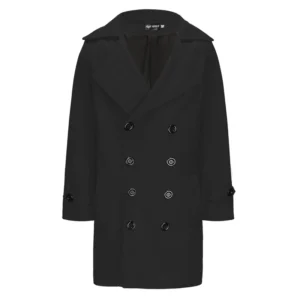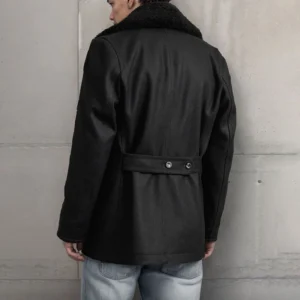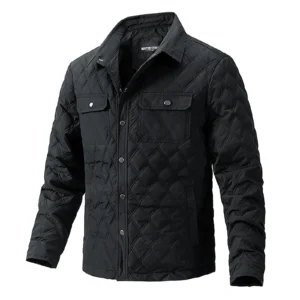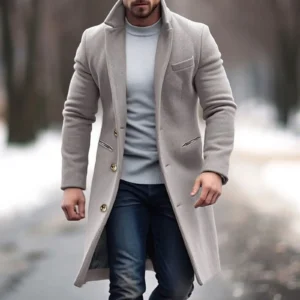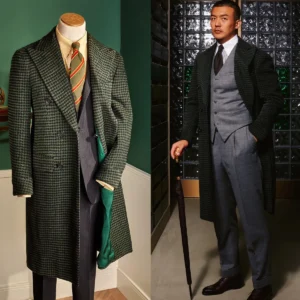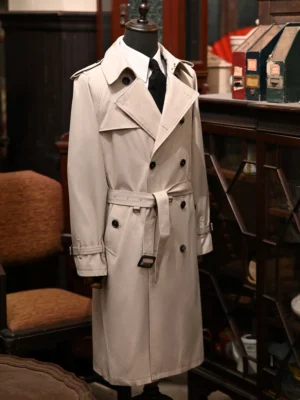Mens Double Breasted Pea Coat
Need a warm, stylish coat? Our men’s double breasted pea coats offer quality wool for lasting comfort. Their classic design looks great and easily handles chilly weather.

Showing all 3 results
Mens Double Breasted Pea Coat, Mens Wool Blend Coat, Mens Wool Pea Coat
Price range: $136.84 through $157.36 Select options This product has multiple variants. The options may be chosen on the product pageMens Double Breasted Pea Coat, Mens Wool Blend Coat, Mens Wool Pea Coat
Price range: $139.96 through $157.12 Select options This product has multiple variants. The options may be chosen on the product pageMens Double Breasted Pea Coat, Mens Hooded Winter Coat, Mens Quilted Coat
Price range: $81.00 through $108.48 Select options This product has multiple variants. The options may be chosen on the product page
Showing all 3 results
The Heritage of Double-Breasted Pea Coats
The double-breasted pea coat stands as a testament to functional design that transcends its practical origins. Born from the harsh demands of naval service, these coats protected sailors against punishing ocean winds and spray before making their transition to civilian wardrobes. The distinctive features—a short length for mobility, dense wool for insulation, and that iconic double-breasted front providing an extra layer of protection—remain virtually unchanged from their maritime beginnings.
What makes these coats truly remarkable is their rare ability to remain relevant and stylish regardless of passing fashion trends. The pea coat’s enduring silhouette speaks to the perfect marriage of form and function, offering protection without sacrificing style. At Metro Cloak, we recognize that these aren’t merely coats, but heritage pieces that connect the modern man to a rich tradition of craftsmanship and practical design.
What Makes a Superior Double-Breasted Pea Coat
Not all pea coats are created equal. The difference between an ordinary coat and an exceptional one lies in the details that many overlook. Premium pea coats start with the fabric selection—traditional Melton wool with at least 70% wool content delivers the perfect balance of warmth, water resistance, and durability. The addition of cashmere elevates the experience, adding softness while maintaining structure.
Beneath the surface, quality reveals itself in the construction. A well-made pea coat features full canvas or at minimum a floating chest piece that allows the coat to mold to your body over time. The lining should be smooth, durable, and extend fully through the sleeves—ideally made from satin, rayon, or in premium coats, silk.
Traditional anchor buttons, typically made from genuine horn or high-quality metal, not only serve as functional closures but as statements of authenticity. The stitching—tight, even, and reinforced at stress points—speaks volumes about the coat’s longevity. When examining potential purchases, these are the markers of quality that ensure your investment will stand the test of time.
Material Excellence: The Foundation of Warmth and Durability
The heart of any exceptional pea coat is its fabric. Traditional navy-issue pea coats were crafted from 32-ounce Melton wool—a substantial fabric that creates an almost impenetrable barrier against the elements. Today’s premium coats typically feature wool in the 22-28 ounce range, striking the perfect balance between protection and wearability.
Higher wool percentages (ideally 80% or above) ensure superior insulation, natural water resistance, and breathability that synthetic materials simply cannot match. Wool’s unique fiber structure creates millions of tiny air pockets that trap body heat while still allowing moisture to escape, preventing the clammy feeling common in lesser materials.
The addition of cashmere or merino wool enhances softness without compromising durability, while a small percentage of synthetic fiber (typically under 20%) can improve wrinkle resistance and longevity. This careful blend of materials results in a coat that performs admirably in diverse conditions, from damp autumn days to frigid winter nights, embodying Metro Cloak’s commitment to all-weather elegance.
Finding Your Perfect Fit
The double-breasted pea coat follows its own fit philosophy. Unlike more relaxed outerwear, a proper wool pea coat should feel comfortably fitted while allowing room for layering. The shoulders represent the most crucial fit point—the seams should align with your natural shoulder edge without overhanging or pulling tight.
When buttoned, the coat should close comfortably with enough room for a sweater underneath. A flat hand should slide easily between your chest and the fabric. The sleeve length should hit at your wrist bone, exposing about half an inch of shirt cuff when your arms are extended.
Common fit mistakes include sizing up too generously (creating a boxy, unflattering silhouette) or choosing a coat too snug for proper layering. The coat’s length should cover your seat but typically end at mid-thigh—proportions that balance protection with visual appeal. Remember that wool will relax slightly with wear, but shoulders and chest fit should be accurate from the start.
Signature Double-Breasted Details
The double-breasted design isn’t merely aesthetic—it serves as functional protection by creating overlapping layers across the chest and torso. Traditional pea coats feature either a 6×2 button arrangement (six buttons with two functional closure points) or the more naval-authentic 8×2 configuration, with rows spaced to maximize weather protection.
The oversized Ulster collar stands as perhaps the most distinctive feature, designed to be flipped up against harsh winds—creating a protective frame around the neck and face when needed. When worn down, this same collar creates a flattering frame for both casual and formal looks.
Slash pockets positioned at an angle aren’t just stylish—they were designed for sailors to easily access while maintaining balance on shifting decks. This practical heritage continues in modern wool coats from Metro Cloak, where authenticity meets contemporary needs. Additional details like shoulder epaulets and cuff straps that once served military purposes now provide distinctive touches that separate superior coats from more basic offerings.
Styling Your Double-Breasted Pea Coat
The pea coat’s versatility becomes apparent through its styling potential. For casual weekends, pair with dark denim, a simple crew neck sweater, and leather boots for an effortless look that remains refined. The coat’s structured shoulders naturally elevate even the most basic attire.
For business settings, layer over tailored trousers and fine merino knitwear or a shirt and tie. The pea coat’s heritage as naval officer attire makes it appropriate for professional environments while maintaining distinctive character that standard overcoats often lack.
Color coordination follows simple principles—navy, the most traditional choice, pairs seamlessly with virtually any outfit. Black offers sleek sophistication for evening or urban settings, while camel or gray provides versatility for business wardrobes. Consider accessories that complement the coat’s rugged refinement: leather gloves, textured scarves, and classic watches enhance the overall impression without competing for attention.
Smart-Casual Statements
The pea coat truly excels in smart-casual territory, bridging the gap between relaxed and refined. Create balanced looks by pairing with oxford shirts and well-fitted chinos or wool trousers—the coat provides structure while these pieces add approachable sophistication.
Footwear choices significantly impact the coat’s presentation: derby shoes or Chelsea boots maintain the smart-casual balance, while quality leather sneakers can introduce contemporary flair without undermining the coat’s inherent elegance.
Texture mixing enhances visual interest—consider a knit tie, textured sweater, or flannel shirt to create depth beneath your coat. These combinations work perfectly for dinner outings, cultural events, or professional settings with relaxed dress codes, demonstrating the remarkable adaptability of this classic garment.
Care & Maintenance Guide
Preserving your pea coat’s appearance and performance requires minimal but consistent care. After each wearing, use a soft-bristled clothes brush to remove surface debris before it settles into the fabric. Allow the coat to air out completely before storing, ideally on a broad wooden hanger that supports the shoulders properly.
For cleaning, most quality wool pea coats should be dry-cleaned only, typically once per season or when visibly soiled. Spot cleaning with a damp cloth can address minor marks. Between cleanings, steam can refresh the fabric and eliminate odors without harsh chemicals.
Seasonal storage deserves attention: clean your coat before storing, use cedar blocks to deter moths, and store in a breathable garment bag—never plastic. These simple practices ensure your winter coat remains an investment piece for many seasons, developing character while maintaining its protective properties.
Frequently Asked Questions
How does the double-breasted style compare to single-breasted overcoats?
Double-breasted pea coats offer superior wind protection thanks to the overlapping front panels that create two layers of fabric across the chest and torso. This design provides significantly better insulation in harsh conditions compared to single-breasted overcoats.
The double-breasted style also creates a more structured silhouette that flatters most body types by broadening the shoulders and creating a defined waist. For men with slimmer builds, this added structure can be particularly beneficial. Single-breasted coats offer more versatility for casual wear and easier layering but sacrifice some of the protective and figure-enhancing benefits that make the double-breasted pea coat such an enduring classic.

